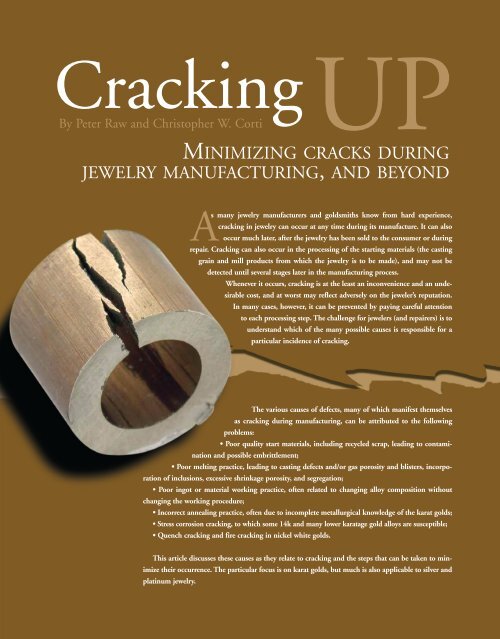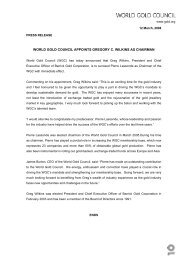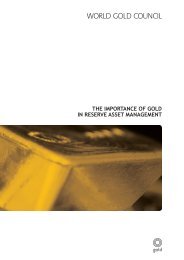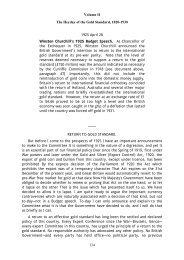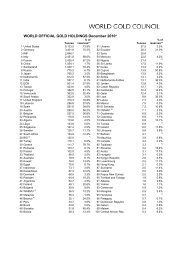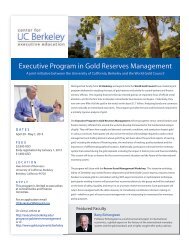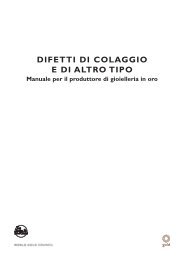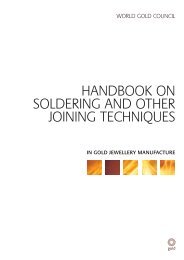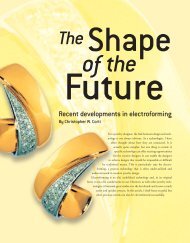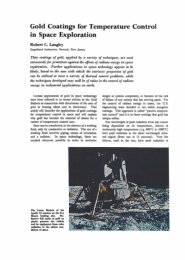AJ033 Cracking UP - World Gold Council
AJ033 Cracking UP - World Gold Council
AJ033 Cracking UP - World Gold Council
You also want an ePaper? Increase the reach of your titles
YUMPU automatically turns print PDFs into web optimized ePapers that Google loves.
<strong>UP</strong><br />
MINIMIZING CRACKS DURING<br />
JEWELRY MANUFACTURING, AND BEYOND<br />
<strong>Cracking</strong><br />
By Peter Raw and Christopher W. Corti<br />
A<br />
s many jewelry manufacturers and goldsmiths know from hard experience,<br />
cracking in jewelry can occur at any time during its manufacture. It can also<br />
occur much later, after the jewelry has been sold to the consumer or during<br />
repair. <strong>Cracking</strong> can also occur in the processing of the starting materials (the casting<br />
grain and mill products from which the jewelry is to be made), and may not be<br />
detected until several stages later in the manufacturing process.<br />
Whenever it occurs, cracking is at the least an inconvenience and an undesirable<br />
cost, and at worst may reflect adversely on the jeweler’s reputation.<br />
In many cases, however, it can be prevented by paying careful attention<br />
to each processing step. The challenge for jewelers (and repairers) is to<br />
understand which of the many possible causes is responsible for a<br />
particular incidence of cracking.<br />
The various causes of defects, many of which manifest themselves<br />
as cracking during manufacturing, can be attributed to the following<br />
problems:<br />
• Poor quality start materials, including recycled scrap, leading to contamination<br />
and possible embrittlement;<br />
• Poor melting practice, leading to casting defects and/or gas porosity and blisters, incorporation<br />
of inclusions, excessive shrinkage porosity, and segregation;<br />
• Poor ingot or material working practice, often related to changing alloy composition without<br />
changing the working procedure;<br />
• Incorrect annealing practice, often due to incomplete metallurgical knowledge of the karat golds;<br />
• Stress corrosion cracking, to which some 14k and many lower karatage gold alloys are susceptible;<br />
• Quench cracking and fire cracking in nickel white golds.<br />
This article discusses these causes as they relate to cracking and the steps that can be taken to minimize<br />
their occurrence. The particular focus is on karat golds, but much is also applicable to silver and<br />
platinum jewelry.
Start MATERIALS<br />
When making karat gold<br />
alloys, it is essential to start with clean, oxide-free metals, whether<br />
they are pure metals or pre-alloys (master alloys). All should be<br />
analyzed or purchased with certificates of analysis. The purity of<br />
gold should be at least 99.9 percent, with lead, tin, bismuth, antimony,<br />
selenium, and tellurium impurities specified as less than 0.01<br />
percent. These impurities can be present in mined gold and can lead<br />
to alloy embrittlement—a tendency to crack when a load is applied,<br />
such as when working the material.<br />
A frequent cause of problems, however, is the use of scrap<br />
gold, which tends to be a recurring source of contamination. This<br />
is particularly true for scrap bought from external sources, commonly<br />
used as a start material in some countries. But even internally-generated<br />
scrap can be problematic, especially if it is recycled<br />
because of prior process failures. The use of scrap to make<br />
new product should be strictly controlled. Preferably, the gold<br />
should be subject to melting and analysis before it is used to make<br />
new alloy ingots, or recycled in investment casting.<br />
Typical contaminants in scrap include refractory materials,<br />
such as investment particles on unclean sprues, oxides<br />
3<br />
from dirty surfaces, silicon from casting alloy, and lead-tin<br />
solder from repaired jewelry. Scrap jewelry containing soldered<br />
joints may introduce indium, germanium, or tin. All<br />
these contaminants can lead to inclusions or alloy embrittlement.<br />
As a result, the only guaranteed safe way of utilizing<br />
scrap is to refine it first.<br />
Embrittlement by low melting point metals (and silicon)<br />
tends to result from the formation of low melting point<br />
metallic second phases. These phases are either the contaminating<br />
metal itself, which generally has extremely low solubility<br />
in gold, or they occur as a reaction product of the contaminant<br />
with gold, silver, or copper. The effect is magnified if the grain size<br />
of the alloy is large, since these second phases tend to be dispersed<br />
as very thin films around the grain boundaries. Fine-grained alloys<br />
will tend to have a lower concentration of embrittling phase per<br />
grain boundary area. Often, these contaminants manifest themselves<br />
as cracking during metal working operations. However, as will<br />
be discussed later, there are other reasons for karat gold alloys failing<br />
during fabrication.<br />
Melting and CASTING A very significant<br />
proportion of karat gold jewelry is manufactured either by investment<br />
casting, using casting grain, or from mill products (sheet,<br />
strip, wire, or tube) that are derived from statically-cast ingots or<br />
continuously-cast material.<br />
Investment (lost wax) castings are prone to embrittlement,<br />
particularly when silicon-containing alloys and scrap are used.<br />
Problems can also arise due to unclean gold scrap (even when it<br />
doesn’t contain silicon), inclusions from crucibles, weak investment<br />
molds, and shrinkage and gas porosity. Large porosity, in<br />
particular, may act to cause cracking during subsequent processing.<br />
Hard refractory inclusions (i.e., ceramic particles from melting<br />
crucibles or investment molds, or “dirt” from the workshop<br />
that falls into the melt) resist deformation during working and act<br />
as crack initiators in the gold alloy. If present on the surface, they<br />
can break out, leaving large surface porosity that is drawn into a<br />
longitudinal surface crack on further working.<br />
Continuous casting of karat gold alloys almost always uses<br />
high density, fine grain graphite for the mold material to ensure<br />
good quality product. It is capable of giving much higher quality<br />
(and higher product yields) because there is no shrinkage pipe, as<br />
occurs with statically-cast ingots. However, erosion of the mold can<br />
lead to graphite inclusions in the melt. Surface defects are also a possibility<br />
if mold wear or sticking<br />
occurs to any extent. By<br />
1<br />
and large, though, continuously-cast<br />
materials seldom<br />
give rise to mechanical defects.<br />
(An example of mech-<br />
2<br />
anical defects from continuously cast materials is Figure 1, which<br />
shows cracks on ring surfaces after working. The rings were made<br />
from continuously-cast 14k tube, and the defects are attributed to<br />
incorrect casting conditions.)<br />
Static casting of ingots tends to be a much simpler operation,<br />
with melting by gas heating, oil-fired furnaces, electric resistance<br />
heating, or induction heating. Induction heating ensures maximum<br />
stirring of the alloy constituents, making it the preferred<br />
method of heating, although other heating methods combined<br />
with physical stirring of the melt with graphite or refractory rods<br />
is commonplace. Crucibles are typically clay-graphite or graphite<br />
(fireclay for nickel white golds, as nickel will react with graphite),<br />
and molds are typically made from iron or water-cooled copper.<br />
OPENING PAGE: PHOTO COURTESY OF GREG NORMANDEAU. FIGURE 1 COURTESY OF DIETER OTT, FEM. FIGURES 2 AND 3 COURTESY OF MARK GRIMWADE.<br />
42 > AJM
FIGURE 4 COURTESY OF MARK GRIMWADE. FIGURE 5 COURTESY OF STEWART GRICE AND FRED KLOTZ. FIGURE 6 COURTESY OF DIETER OTT, FEM.<br />
Static casting can be a source of several problems, including:<br />
Shrinkage and pipes. When a cast ingot solidifies, it shrinks.<br />
This becomes evident as a central pipe at the top of the ingot. (Figure<br />
2) This pipe must be cut off before working the ingot, otherwise a<br />
central defect will be introduced that will elongate upon working.<br />
This central defect is likely to result in subsequent longitudinal cracking.<br />
The pipe will be more pronounced if the casting temperature is<br />
too high, so it is normal practice to restrict the casting temperature to<br />
no more than 200°F/93°C above the liquidus temperature of the<br />
alloy. High casting temperatures also encourage large grain sizes,<br />
which decrease the ductility of the alloy and magnify the effect of any<br />
low melting point impurities that might be present.<br />
Blistering and porosity. Surface blistering or internal gas<br />
porosity can show up later in fabrication operations as surface<br />
5<br />
4<br />
defects or cracks. In this situation, gas from the start material (dissolved<br />
gas or damp materials) or gas dissolved during the melting<br />
operation (aggravated by too high a melting temperature, lack of a<br />
protective atmosphere or a flux, and use of gas melting) evolves as<br />
porosity during solidification. Initial working may flatten the pores<br />
and cause small laminations and cracks, or it may close the porosity,<br />
only to have the gas expand later during annealing operations and<br />
reappear as blisters.<br />
Inclusions. Inclusions can be incorporated into the melt from<br />
several sources, including erosion of the crucible (replace crucibles<br />
6<br />
before significant wear occurs), from furnace insulation or lining, or<br />
from broken stirring rods. They can also be caused by a reaction<br />
between the atmosphere and alloying element (for example, oxygen<br />
and copper forming copper oxide), or the use of grain refiners that<br />
have not been dispersed correctly, particularly iridium, which is very<br />
insoluble in gold and forms hard clusters of particles. Such inclusions<br />
can give rise to cracks or failure during subsequent working because<br />
they act as stress concentrators, which initiate cracks.<br />
Surface defects. Surface defects on the ingot can also lead to<br />
cracks. These defects can arise due to poor melting and casting practices.<br />
They include surface inclusions, oxidation, mechanical damage,<br />
and solidified splashes during casting that stick to the mold wall.<br />
Many of these problems can be avoided by inspecting all ingot surfaces<br />
and cleaning away all evidence of defects before any working<br />
operations are undertaken. If necessary, the ingot surface might<br />
have to be milled to ensure it is clean and flat.<br />
<strong>Cracking</strong> During FABRICATION<br />
<strong>Cracking</strong> can occur at any stage of fabrication, including:<br />
Overworking. All forms of metal working—including sheet<br />
and rod rolling, wire and tube drawing,<br />
blanking, stamping, coining, spinning and<br />
raising, milling, turning and machining,<br />
and simply bending by hand—result in the<br />
material becoming harder and less ductile.<br />
The degree to which it hardens and loses<br />
ductility depends on the amount of deformation<br />
imparted. If material is overworked, the ductility reduces<br />
to zero, and it will crack.<br />
Annealing restores the material’s ductility, and so is normally<br />
performed at appropriate stages in the working process. The rate<br />
at which alloys work-harden and the extent to which they can be<br />
worked before annealing varies from alloy to alloy. Typically, karat<br />
gold alloys can be worked up to about 70 percent reduction in<br />
area (strain) before they require annealing. However, there are<br />
considerable variations; for example, nickel white golds harden<br />
rapidly and normally require annealing after a 35 or 40 percent<br />
reduction. On the other hand, fine gold and some of the high<br />
karat golds can be worked well in excess of 90 percent reduction<br />
in area before annealing.<br />
Overworking can cause several problems. For example, edge<br />
cracking during rolling of sheet material is normally the result of<br />
overworking. To avoid further problems, the edges must be<br />
trimmed, since rolling after annealing will increase the danger of<br />
some cracks running in towards the sheet center. (Figure 3)<br />
Problems that occur during rod rolling include the formation of<br />
fins, which are caused when too much material is pushed into the<br />
March 2003 < 43
44 > AJM<br />
rolling groove, so that the rolls are forced<br />
apart and excess metal is squeezed out sideways.<br />
(Figure 4) These fins are then rolled<br />
into the rod, becoming laps. Both fins and<br />
laps can open up as cracks at later stages of<br />
fabrication. Their formation can be prevented<br />
by avoiding too large a reduction<br />
and by rotating the rod through 90 degrees<br />
between successive passes.<br />
Localized overworking can also cause<br />
cracking during sheet metal forming<br />
operations, such as stamping or deep<br />
drawing. (Figure 5) Fracturing occurs at<br />
the weakest or thinnest point, which in<br />
forming operations is usually where the<br />
sheet bends around the tool. It may be<br />
necessary to partially shape the component<br />
in one die-set and then further form<br />
it in another die-set. Selection of the correct<br />
material and processing conditions<br />
are important, and will depend on individual<br />
circumstances.<br />
Embrittlement by impurities. As we<br />
discussed earlier, certain impurities, including<br />
silicon, will embrittle gold. Any attempt<br />
at working embrittled material will result in<br />
cracking. (Figure 6 shows cracking in 18k<br />
gold due to silicon embrittlement.)<br />
Another reported source of embrittlement<br />
is contamination from lead formers.<br />
Manual working, such as raising, and repair<br />
operations often involve hand-working on a<br />
soft former, frequently made of lead, to prevent<br />
surface damage. We know of an example<br />
of embrittlement in which lead from the<br />
former contaminated the surface of the<br />
gold, with the lead diffusing into the gold<br />
during subsequent annealing or soldering.<br />
Because of the possibility of such contamination<br />
that can lead to embrittlement, the<br />
use of metallic lead in contact with gold is<br />
risky. If the technique is considered essential,<br />
the gold should be separated from the<br />
lead with a tough grade of paper.<br />
Incorrect annealing practice. Incorrect<br />
cooling conditions after annealing<br />
can, paradoxically, lead to hardening
ather than softening in some karat golds.<br />
On subsequent working, the material<br />
cracks. <strong>Gold</strong>s in the red to yellow range,<br />
8k to 18k, should be rapidly cooled after<br />
annealing by quenching directly in water;<br />
this maintains a soft ductile condition,<br />
whereas slow cooling results in hardening.<br />
Repairers should also anneal and water<br />
quench such jewelry items before re-sizing<br />
or repairing for this reason.<br />
Over-annealing the metal at too high a<br />
temperature and/or for too long a time can<br />
also result in cracking. Over-annealing produces<br />
a large, coarse grain size, and subsequent<br />
deformation can lead to premature<br />
cracking and fracture, as well as an “orange<br />
peel” surface. This is a problem particularly<br />
with torch annealing, where the capability to<br />
control temperature is limited. To avoid<br />
over-annealing, use the lowest effective temperature<br />
and only the time needed.<br />
The issue of cracking arising during<br />
the fabrication of karat gold jewelry, or<br />
later during service or repair, can be complex.<br />
Although there are well-defined<br />
causes for cracking, a crack’s appearance is<br />
not uniquely associated with one particular<br />
cause. Establishing the precise reason<br />
for failure may require specialized equipment<br />
and knowledge. The situation may<br />
be further complicated by defects that<br />
arise as a result of more than one cause.<br />
However, there are probably two<br />
aspects of manufacturing that contribute<br />
most towards minimizing the production<br />
of defective or scrap jewelry products:<br />
First, a good understanding of the metallurgy<br />
of the karat golds and, second, the<br />
establishment of good manufacturing<br />
practices for materials and products—and<br />
the strict adherence to those practices. ◆<br />
Peter Raw is a technology consultant in<br />
Surrey, UK, and Christopher Corti is director,<br />
International Technology, at the <strong>World</strong><br />
<strong>Gold</strong> <strong>Council</strong>, London.<br />
AJM READERS’ RESOURCES<br />
WORKING<br />
WITH<br />
GOLD<br />
“Handbook of Casting and Other<br />
Defects in <strong>Gold</strong> Jewelry Manufacture,”<br />
Dieter Ott, <strong>World</strong> <strong>Gold</strong> <strong>Council</strong>, London,<br />
1998.<br />
“Causes and Prevention of Defects<br />
in Wrought Alloys,” Mark Grimwade,<br />
<strong>Gold</strong> Technology, No. 36, Winter 2002.<br />
“Live and Let Die (Struck),” Fred<br />
Klotz and Stewart Grice, <strong>Gold</strong> Technology,<br />
No. 36, Winter 2002.<br />
“But I’ve Always Done It This Way.<br />
Technical Support—It Makes a<br />
Difference,” Stewart Grice, <strong>Gold</strong> Technology,<br />
No. 25, April 1999. Also in<br />
Proceedings, Santa Fe Symposium on<br />
Jewelry Manufacturing Technology,<br />
1998, Met-Chem Research.<br />
Note: <strong>Gold</strong> Technology and the<br />
“Handbook on Defects” are published by<br />
<strong>World</strong> <strong>Gold</strong> <strong>Council</strong>. Copies are available<br />
from the London office. To obtain<br />
copies, e-mail chris.corti@gold.org. Recent<br />
issues of <strong>Gold</strong> Technology are also<br />
available online at www.gold.org.<br />
For additional resources, including<br />
information on minimizing stress corrosion<br />
cracking, quench cracking, and fire<br />
cracking, visit AJM Online at www<br />
.ajm-magazine.com.<br />
March 2003 < 47


